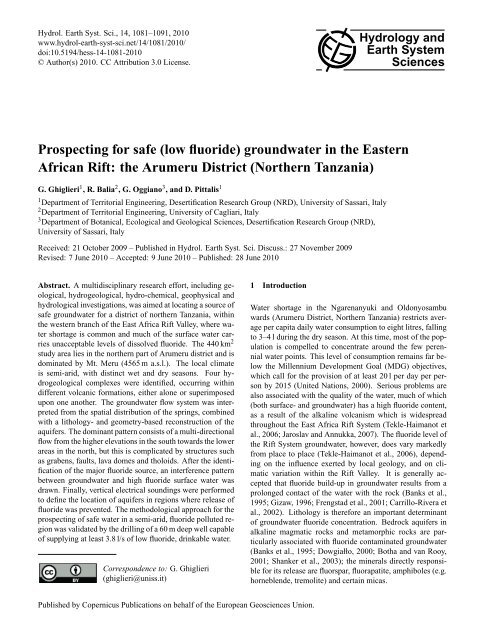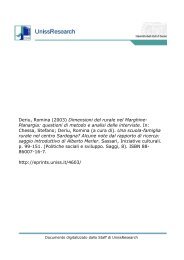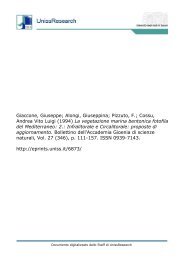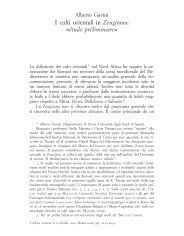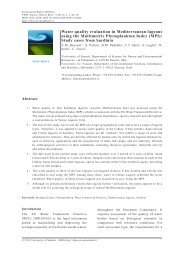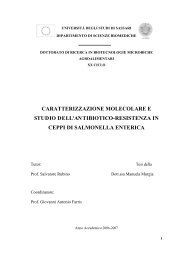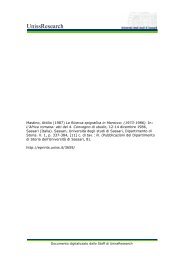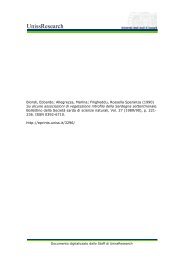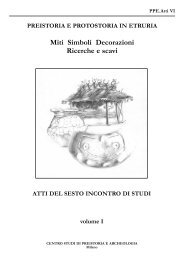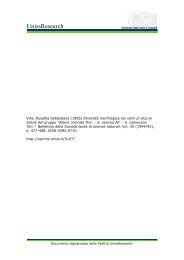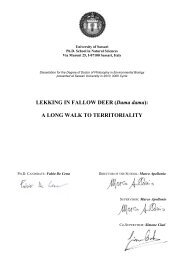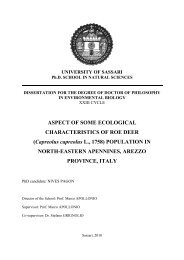Prospecting for safe (low fluoride) - Hydrology and Earth System ...
Prospecting for safe (low fluoride) - Hydrology and Earth System ...
Prospecting for safe (low fluoride) - Hydrology and Earth System ...
Create successful ePaper yourself
Turn your PDF publications into a flip-book with our unique Google optimized e-Paper software.
Hydrol. <strong>Earth</strong> Syst. Sci., 14, 1081–1091, 2010<br />
www.hydrol-earth-syst-sci.net/14/1081/2010/<br />
doi:10.5194/hess-14-1081-2010<br />
© Author(s) 2010. CC Attribution 3.0 License.<br />
<strong>Hydrology</strong> <strong>and</strong><br />
<strong>Earth</strong> <strong>System</strong><br />
Sciences<br />
<strong>Prospecting</strong> <strong>for</strong> <strong>safe</strong> (<strong>low</strong> <strong>fluoride</strong>) groundwater in the Eastern<br />
African Rift: the Arumeru District (Northern Tanzania)<br />
G. Ghiglieri 1 , R. Balia 2 , G. Oggiano 3 , <strong>and</strong> D. Pittalis 1<br />
1 Department of Territorial Engineering, Desertification Research Group (NRD), University of Sassari, Italy<br />
2 Department of Territorial Engineering, University of Cagliari, Italy<br />
3 Department of Botanical, Ecological <strong>and</strong> Geological Sciences, Desertification Research Group (NRD),<br />
University of Sassari, Italy<br />
Received: 21 October 2009 – Published in Hydrol. <strong>Earth</strong> Syst. Sci. Discuss.: 27 November 2009<br />
Revised: 7 June 2010 – Accepted: 9 June 2010 – Published: 28 June 2010<br />
Abstract. A multidisciplinary research ef<strong>for</strong>t, including geological,<br />
hydrogeological, hydro-chemical, geophysical <strong>and</strong><br />
hydrological investigations, was aimed at locating a source of<br />
<strong>safe</strong> groundwater <strong>for</strong> a district of northern Tanzania, within<br />
the western branch of the East Africa Rift Valley, where water<br />
shortage is common <strong>and</strong> much of the surface water carries<br />
unacceptable levels of dissolved <strong>fluoride</strong>. The 440 km 2<br />
study area lies in the northern part of Arumeru district <strong>and</strong> is<br />
dominated by Mt. Meru (4565 m a.s.l.). The local climate<br />
is semi-arid, with distinct wet <strong>and</strong> dry seasons. Four hydrogeological<br />
complexes were identified, occurring within<br />
different volcanic <strong>for</strong>mations, either alone or superimposed<br />
upon one another. The groundwater f<strong>low</strong> system was interpreted<br />
from the spatial distribution of the springs, combined<br />
with a lithology- <strong>and</strong> geometry-based reconstruction of the<br />
aquifers. The dominant pattern consists of a multi-directional<br />
f<strong>low</strong> from the higher elevations in the south towards the <strong>low</strong>er<br />
areas in the north, but this is complicated by structures such<br />
as grabens, faults, lava domes <strong>and</strong> tholoids. After the identification<br />
of the major <strong>fluoride</strong> source, an interference pattern<br />
between groundwater <strong>and</strong> high <strong>fluoride</strong> surface water was<br />
drawn. Finally, vertical electrical soundings were per<strong>for</strong>med<br />
to define the location of aquifers in regions where release of<br />
<strong>fluoride</strong> was prevented. The methodological approach <strong>for</strong> the<br />
prospecting of <strong>safe</strong> water in a semi-arid, <strong>fluoride</strong> polluted region<br />
was validated by the drilling of a 60 m deep well capable<br />
of supplying at least 3.8 l/s of <strong>low</strong> <strong>fluoride</strong>, drinkable water.<br />
Correspondence to: G. Ghiglieri<br />
(ghiglieri@uniss.it)<br />
1 Introduction<br />
Published by Copernicus Publications on behalf of the European Geosciences Union.<br />
Water shortage in the Ngarenanyuki <strong>and</strong> Oldonyosambu<br />
wards (Arumeru District, Northern Tanzania) restricts average<br />
per capita daily water consumption to eight litres, falling<br />
to 3–4 l during the dry season. At this time, most of the population<br />
is compelled to concentrate around the few perennial<br />
water points. This level of consumption remains far be<strong>low</strong><br />
the Millennium Development Goal (MDG) objectives,<br />
which call <strong>for</strong> the provision of at least 20 l per day per person<br />
by 2015 (United Nations, 2000). Serious problems are<br />
also associated with the quality of the water, much of which<br />
(both surface- <strong>and</strong> groundwater) has a high <strong>fluoride</strong> content,<br />
as a result of the alkaline volcanism which is widespread<br />
throughout the East Africa Rift <strong>System</strong> (Tekle-Haimanot et<br />
al., 2006; Jaroslav <strong>and</strong> Annukka, 2007). The <strong>fluoride</strong> level of<br />
the Rift <strong>System</strong> groundwater, however, does vary markedly<br />
from place to place (Tekle-Haimanot et al., 2006), depending<br />
on the influence exerted by local geology, <strong>and</strong> on climatic<br />
variation within the Rift Valley. It is generally accepted<br />
that <strong>fluoride</strong> build-up in groundwater results from a<br />
prolonged contact of the water with the rock (Banks et al.,<br />
1995; Gizaw, 1996; Frengstad et al., 2001; Carrillo-Rivera et<br />
al., 2002). Lithology is there<strong>for</strong>e an important determinant<br />
of groundwater <strong>fluoride</strong> concentration. Bedrock aquifers in<br />
alkaline magmatic rocks <strong>and</strong> metamorphic rocks are particularly<br />
associated with <strong>fluoride</strong> contaminated groundwater<br />
(Banks et al., 1995; Dowgiałło, 2000; Botha <strong>and</strong> van Rooy,<br />
2001; Shanker et al., 2003); the minerals directly responsible<br />
<strong>for</strong> its release are fluorspar, fluorapatite, amphiboles (e.g.<br />
horneblende, tremolite) <strong>and</strong> certain micas.
1082 G. Ghiglieri et al.: <strong>Prospecting</strong> <strong>for</strong> <strong>safe</strong> groundwater in the Eastern African Rift<br />
Fig. 1. Geographical map of the study area.<br />
Since excessive consumption of <strong>fluoride</strong> can result in dental<br />
or skeletal fluorosis (Moller et al., 1970; Tekle-Haimanot<br />
et al., 2006), the consumption of <strong>fluoride</strong>-contaminated water<br />
in the Rift Valley has made these conditions commonplace<br />
throughout Ethiopia (Lester, 1974; Tekle Haimanot et<br />
al., 1987; Kloos <strong>and</strong> Tekle-Haimanot, 1999), Sudan (Smith<br />
et al., 1953) <strong>and</strong> Tanzania (Kilham <strong>and</strong> Hecky, 1973). Particularly<br />
high <strong>fluoride</strong> levels are found in the waters of Elementaita<br />
(1640 mg/l) <strong>and</strong> Nakuru (2800 mg/l) lakes in Kenya<br />
(Tekle-Haimanot et al., 2006). The World Health Organization<br />
suggested in 2006 an acceptable limit of 1.5 mg/l <strong>fluoride</strong>,<br />
but the Tanzanian government has been <strong>for</strong>ced by an<br />
over-riding need to prevent water shortage, to raise this limit<br />
to 8 mg/l. The urgent need to discover alternative sources of<br />
<strong>safe</strong> groundwater has prompted the present multidisciplinary<br />
study of a typical rural area located within a semi-arid microenvironment<br />
dominated by alkaline volcanic rocks. The aims<br />
of the study were to identify the main local source of <strong>fluoride</strong>,<br />
to locate aquifers unaffected by <strong>fluoride</strong> infiltration/release,<br />
<strong>and</strong> to develop strategies to exploit <strong>safe</strong> groundwater.<br />
2 Study area<br />
2.1 Location, climatic <strong>and</strong> physiographic setting<br />
The project was sited in the 2966 km 2 Arumeru district,<br />
Arusha region, northern Tanzania, lying to the west of<br />
Mt. Kilimanjaro, to the north of Mt. Meru, to the east of<br />
the Arusha to Nairobi (Kenya) road, <strong>and</strong> to the south of<br />
the Kenyan Amboseli National Park (Fig. 1). The district<br />
is administratively divided into six divisions, 37 wards <strong>and</strong><br />
133 villages. The 440 km 2 project working area lies in the<br />
northern part of the district, around 50 km from Arusha, is<br />
bounded by Mt. Meru (4565 m a.s.l.) <strong>and</strong> the Arusha National<br />
Park, <strong>and</strong> includes nine villages in the Oldonyo Sambu<br />
<strong>and</strong> Ngarenanyuki wards. Three main ethnic groups present<br />
are the Wameru (mainly farmers) <strong>and</strong> the Waarusha <strong>and</strong> Maasai<br />
(mainly pastoralists). Despite its proximity to the equator,<br />
the study area has an Afro-Alpine semi-arid climate,<br />
characterized by two distinct seasons. The main wet season<br />
lasts from June to September <strong>and</strong> contributes ∼70% of<br />
the annual rainfall, while the minor wet season lasts from<br />
mid February to mid May. The remaining months are effectively<br />
dry, although occasional showers do occur during this<br />
period. The mean annual minimum <strong>and</strong> maximum temperatures<br />
are 20.6 ◦ C <strong>and</strong> 28.5 ◦ C, respectively, <strong>and</strong> the mean<br />
annual rainfall is 535.3 mm (AA.VV., 2000; Gea, 2005). As<br />
illustrated in Fig. 1, the topography of the area is dominated<br />
by the volcanic cone of Mt. Meru <strong>and</strong> its slopes cover most<br />
of the area. The remaining l<strong>and</strong> is covered by alluvial fans<br />
fed from Mt. Meru. Recently active small volcanic cones are<br />
present in the north-western part of Mt. Meru, <strong>and</strong> a number<br />
of small maar-type flat craters are also present. The Big Momela<br />
<strong>and</strong> the Small Momela lakes, lying within Arusha National<br />
Park to the east of Mt. Meru, are saline <strong>and</strong> alkaline.<br />
The drainage pattern around Mt. Meru is radial, but further<br />
Hydrol. <strong>Earth</strong> Syst. Sci., 14, 1081–1091, 2010 www.hydrol-earth-syst-sci.net/14/1081/2010/
G. Ghiglieri et al.: <strong>Prospecting</strong> <strong>for</strong> <strong>safe</strong> groundwater in the Eastern African Rift 1083<br />
Fig. 2. Geological-hydrogeological map of the study area, indicating the location of water points.<br />
down the slopes, many of the stream courses have been modified<br />
by tilting <strong>and</strong> capture. To the east <strong>and</strong> north-east of<br />
Mt. Meru, the only perennial stream is the Engare Nanyuki<br />
River, the waters of which have a high <strong>fluoride</strong> content, since<br />
they emerge from a spring yielding ∼5 l/s of water with a <strong>fluoride</strong><br />
content of 60 ppm. This stream f<strong>low</strong>s northwards into<br />
the inner Amboseli Basin <strong>and</strong> is used locally <strong>for</strong> irrigation<br />
purposes.<br />
2.2 Geological <strong>and</strong> hydrogeological setting<br />
The fol<strong>low</strong>ing general geological descriptions are based on<br />
the Geological Sheet “Arusha”, Quarter Degree Sheet 55,<br />
1983, scale 1:125 000 – Geological Survey of Tanzania,<br />
while the hydrogeological setting is based on the current research<br />
activity.<br />
The volcano-sedimentary sequences of the study area are<br />
Cenozoic; older ones date back to the Miocene-Pliocene,<br />
while the last recorded eruption occurred in the early 20th<br />
century. The lithology is dominated by volcanic rocks with<br />
some alluvial deposits (Fig. 2). No crystalline basement<br />
outcrops occur in the area, but they are present at shal<strong>low</strong><br />
depths just a few kilometers to the north of the study area.<br />
Mt. Meru is considered as an active volcano with alkaline<br />
magmatic activity, typical within the East Africa Rift <strong>System</strong>.<br />
Its last documented eruption was in 1910, when it produced<br />
small emissions of black ash over a few days from the<br />
Ash Cone. As recently as 1954, a significant amount of fumarolic<br />
activity was recorded in the Ash Cone area, but by<br />
1974 neither fumarolic activity nor anomalous soil temperatures<br />
remained detectable. Major rift faults are located in the<br />
north-western portion of the research area. Linear features<br />
<strong>and</strong> benches are common on the flanks of Mt. Meru, <strong>and</strong> it<br />
is highly probable that the early volcanic structure has been<br />
block-faulted. In the central area, the direction of the faults<br />
varies from north/south to north-north-east/south-south-west<br />
(Uwiro graben); in the north-western area, the trend is northwest/south-east<br />
(parasitic cone alignment). However, thick<br />
mantling ash <strong>and</strong> other younger <strong>for</strong>mations hinder any precise<br />
mapping of faults. The age of this faulting lies between<br />
that of the flood lavas (2.3 My BP) <strong>and</strong> the parasitic cones<br />
(1.7 My BP), since some of the latter’s lava covers the fault<br />
scarp. This dating (∼2.1 My BP) is consistent with the estimated<br />
age of other fault-phases (AA.VV., 1983).<br />
The aquifer geometry, storage capacity, permeability,<br />
recharge areas, etc. of the study area have been assessed<br />
by combining the existing geological map (AA.VV., 1983)<br />
www.hydrol-earth-syst-sci.net/14/1081/2010/ Hydrol. <strong>Earth</strong> Syst. Sci., 14, 1081–1091, 2010
1084 G. Ghiglieri et al.: <strong>Prospecting</strong> <strong>for</strong> <strong>safe</strong> groundwater in the Eastern African Rift<br />
with fresh hydrogeological <strong>and</strong> geophysical surveys carried<br />
out in the frame of the present research. The main aquifer<br />
systems consist of volcanic <strong>for</strong>mations, occurring singularly<br />
or superimposed upon one another. Subordinate perched<br />
aquifers (some previously localized) are present in some sedimentary<br />
<strong>for</strong>mations. The thickness of the volcanic rocks is<br />
only approximately known because of uncertainties associated<br />
with the geological <strong>and</strong> geomorphological events which<br />
occurred during the Cenozoic era. However, it is clear that<br />
these events have heavily influenced the geometry of the<br />
aquifers, the recharge <strong>and</strong> discharge areas <strong>and</strong> the groundwater<br />
quality. The scale of the map <strong>and</strong> the amount of available<br />
data, however, prevents a detailed mapping of all these<br />
parameters. From a hydrogeological point of view, the lithostratigraphical<br />
<strong>for</strong>mations can be grouped into two main hydrogeological<br />
units, namely a volcanic <strong>and</strong> a sedimentary<br />
unit (Fig. 2).<br />
2.2.1 Volcanic hydrogeologic unit<br />
This unit is divided into four hydrogeologic complexes:<br />
– Meru west Group (Nvm);<br />
– Lahars of various ages (Nzd1), Ngare Nanyuki lahars<br />
(Nzd2), Momella Lahar (Nzd3);<br />
– Main cone group (Nvm), Ash cone group (Nvn);<br />
– Mantling ash (Nvf);<br />
Meru west Group (Nvm) complex<br />
This <strong>for</strong>mation belongs to the “older extrusive”, <strong>and</strong> is exposed<br />
on the west side of Mt. Meru. The rocks consist predominantly<br />
of nephelinite lavas <strong>and</strong> breccias which contain<br />
dominant phonolite clasts. The aquifer hosted in this <strong>for</strong>mation<br />
has fractured permeability.<br />
Lahars of various age (Nzd1, Nzd2, Nzd3) complex<br />
From a hydrogeological point of view, the lahars can be<br />
grouped within a single complex. Lahars (Nzd1) of considerable<br />
extension are commonly found interbedded with sedimentary<br />
sequences. These lahars are characterized by the<br />
presence of large <strong>and</strong> abundant boulders of feldsparphyric<br />
phonolite, with alkali feldspar phenocrysts occurring within<br />
a fine-grained matrix of variable hardness. Nzd2 <strong>and</strong> Nzd3<br />
are exposed on the north-eastern <strong>and</strong> eastern slopes of the<br />
volcano, the <strong>for</strong>mer near Ngare Nanyuki <strong>and</strong> Uwiro graben,<br />
<strong>and</strong> the latter near the Momella lakes. The aquifers hosted in<br />
these rocks have double permeability, as they are both fractured<br />
<strong>and</strong>, to some extent, porous.<br />
Main cone group (Nvm) complex<br />
The Mt. Meru volcano was active from 0.20 to 0.08 My<br />
BP. Volcanic activity extended the main cone to an alti-<br />
tude of at least 4877 m a.s.l., <strong>and</strong> perhaps was considerably<br />
higher at one time. The Main Cone group (Nvm) <strong>and</strong> Little<br />
Mt. Meru group (Nvp) materials are predominantly volcanic<br />
breccias <strong>and</strong> tuffs of many grain sizes, but phonolitic<br />
<strong>and</strong> nephelinitic (Nv) lavas are sporadically intercalated. The<br />
aquifer hosted in these rocks has double permeability (fractured<br />
<strong>and</strong> porous). The elevation difference between the<br />
recharge <strong>and</strong> discharge areas al<strong>low</strong>s <strong>for</strong> the infiltration of<br />
rain water, particularly where the permeability is high (intensive<br />
fracturing). Along with a considerable number of<br />
high-yielding springs, this structure is responsible <strong>for</strong> the<br />
groundwater having a particularly short residence time. A<br />
further feature of the Main Cone group is the common occurrence<br />
of viscous domes or tholoids (Nvg), usually of<br />
feldsparphyric phonolite composition. These can occur at all<br />
levels, although there is a zone of especially large adventitious<br />
tholoids on the northern flanks (i.e. Mt. Songe). The occurrence<br />
of domes constitutes a lateral hydrogeological impermeable<br />
limit, which limits the circulation of groundwater.<br />
Mantling ash (Nvf) complex<br />
Thick ash, pumice <strong>and</strong> tuff deposits overlie large areas of the<br />
foothills of Mt. Meru, especially on its western slopes. In<br />
the study area, there are outcrops near Oldonyo Sambu <strong>and</strong><br />
Kisimiri (north of Mt. Meru). This <strong>for</strong>mation, due to its finegrained<br />
nature <strong>and</strong> clay alteration, is practically impermeable,<br />
so no springs emerge from it. Sometimes the complex<br />
underlies or surrounds an aquifer.<br />
2.2.2 Sedimentary hydrogeologic unit<br />
This unit is made up of fine-grained alluvial <strong>and</strong> lacustrine<br />
sediments, <strong>and</strong> hence is characterized by a <strong>low</strong> transmissivity.<br />
The occurrence of these sediments generates a swampy<br />
flatl<strong>and</strong> crossed by the Engare Nanyuki River, which terminates<br />
towards the west in an area scattered with alkaline<br />
lakes. A perched, <strong>low</strong> productivity aquifer occurs in this <strong>for</strong>mation<br />
– of the few springs present, most have only a poor<br />
yield.<br />
3 Materials <strong>and</strong> methods<br />
3.1 Hydrogeological surveys<br />
The hydrogeological survey, which was extended beyond the<br />
limits of the two study wards, identified <strong>and</strong> catalogued 52<br />
water points <strong>and</strong> 46 springs (30 in the Ngarenanyuki ward<br />
<strong>and</strong> 16 in Oldonyosambu), <strong>and</strong> included six surface water<br />
samples (rivers <strong>and</strong> lakes). For each water point, the fol<strong>low</strong>ing<br />
parameters were recorded: elevation, geographical coordinates<br />
(GPS), pH, electrical conductivity, temperature, <strong>fluoride</strong><br />
content, yield (estimated values), hydrogeological characteristics<br />
<strong>and</strong> spring classification (Tables 1 <strong>and</strong> 2). Each<br />
water point was identified by an alphanumeric code. The in<br />
Hydrol. <strong>Earth</strong> Syst. Sci., 14, 1081–1091, 2010 www.hydrol-earth-syst-sci.net/14/1081/2010/
G. Ghiglieri et al.: <strong>Prospecting</strong> <strong>for</strong> <strong>safe</strong> groundwater in the Eastern African Rift 1085<br />
Fig. 3. Location map of the electrical soundings in the Ngarenanyuki ward. Sub-areas defined as explained in Table 3. For the geological<br />
legend, see Fig. 2.<br />
situ analysis of the groundwater samples included <strong>fluoride</strong><br />
content, pH, electrical conductivity <strong>and</strong> temperature. Fluoride<br />
were measured using a Fluoride LR Photometer (Hanna<br />
Instrument HI 93739), while the temperature, pH <strong>and</strong> electrical<br />
conductivity at 25 ◦ C were measured using a portable pHconductivity<br />
meter (HI 98130 HANNA Instruments). Readings<br />
were taken at various times during the dry <strong>and</strong> wet seasons.<br />
For each water point, the data were entered into a digital<br />
database <strong>and</strong> GIS, using ArcGIS v9.2 <strong>and</strong> the open source<br />
software gvSIG. The location of each water point was plotted<br />
to al<strong>low</strong> a view of the distribution of all parameters, in<br />
particular the <strong>fluoride</strong> content (Fig. 2).<br />
3.2 Geophysical surveys<br />
The geophysical survey was confined to the Ngarenanyuki<br />
<strong>and</strong> Oldonyosambu wards, <strong>and</strong> was intended to evaluate the<br />
local groundwater resources. Relevant data were acquired<br />
with a VES (Vertical Electrical Sounding) technique, using<br />
a Schlumberger electrode array <strong>and</strong> an ABEM Terrameter<br />
SAS 300. The resulting apparent resistivity curves were interpreted<br />
by a computer program based on the linear digital<br />
filtering method (Koefoed, 1972, 1979; O’Neill <strong>and</strong> Merrick,<br />
1984). Current software packages based on this approach are<br />
able to cope with extreme apparent resistivity contrasts <strong>and</strong><br />
to deal with a large number of layers. In all, 15 soundings<br />
were taken in the Oldonyosambu ward <strong>and</strong> 33 in the Ngarenanyuki<br />
ward. In the <strong>for</strong>mer, no clear signature of any exploitable<br />
groundwater could be inferred from the apparent<br />
resistivity curves, but in the Ngarenanyuki ward, it was possible<br />
to locate several potential sources of groundwater. The<br />
VES position map <strong>for</strong> the Ngarenanyiuki ward is shown in<br />
Fig. 3.<br />
4 Results<br />
The majority of the springs producing <strong>low</strong> <strong>fluoride</strong> content<br />
water (be<strong>low</strong> the national st<strong>and</strong>ard <strong>for</strong> rural water) emerged<br />
from either basaltic or phonolitc unaltered lava, in the main<br />
located at high altitudes within the Mt. Meru Main Cone<br />
Group Complex, <strong>and</strong> – although to a lesser extent – along<br />
its northern <strong>low</strong>er slopes (Fig. 2 <strong>and</strong> Table 1). High <strong>fluoride</strong><br />
content water emerged from lahars <strong>and</strong> lacustrine deposits.<br />
A notable exception to this general pattern was represented<br />
by spring 26 Eng (Fig. 2), sited within the Mt. Meru cone at<br />
2502 m a.s.l. Given its water temperature (22.4 ◦ C) <strong>and</strong> location,<br />
this spring is probably of hydrothermal origin; it feeds<br />
the Engare Nanyuky River at a rate of 6 l/s, <strong>and</strong> its water contains<br />
59–68 mg/l <strong>fluoride</strong>. As such, it represents a source of<br />
pollution to both the river <strong>and</strong> any dependent aquifers, particularly<br />
the area of structural <strong>low</strong> within the Uwiro graben,<br />
where some epiclastite-hosted aquifers are fed from the river.<br />
Epiclastite <strong>and</strong> proximal lahars are separated by paleosoils<br />
(Fig. 4) which are able to concentrate <strong>and</strong> then release <strong>fluoride</strong><br />
thanks to the anion exchange capacity of both phillosilicates<br />
<strong>and</strong> zeolites, which are present as alteration products<br />
of the ash matrix.<br />
www.hydrol-earth-syst-sci.net/14/1081/2010/ Hydrol. <strong>Earth</strong> Syst. Sci., 14, 1081–1091, 2010
1086 G. Ghiglieri et al.: <strong>Prospecting</strong> <strong>for</strong> <strong>safe</strong> groundwater in the Eastern African Rift<br />
Table 1. Summary of springs attributes.<br />
ID Collect UTM UTM Altitude Spring Spring regimen Spring geologic Discharge T Cond pH F<br />
Spring data East North (m a.s.l.) type classification (l/s) ( ◦ C) (mS/cm) (mg/l)<br />
1 eng 18 Feb 07 252 273 9 648 852 2249 localized catched, perennial Fracture, Nvm 0.15 18.0 0.64 7.4 3.0<br />
2 eng 18 Feb 07 252 156 9 648 544 2276 localized catched down the valley,<br />
perennial<br />
Fracture, Nvm N/A 15.0 0.50 6.0 1.3<br />
3 eng 21 Feb 07 259 060 9 651 282 1500 diffused not catched, perennial Gravity, contact,<br />
Nzd1<br />
N/A 24.3 0.74 7.5 4.9<br />
4 eng 7 Mar 07 261 073 9 648 602 1453 N/A catched in irrigation canal, Gravity, contact, N/A 23.0 0.73 6.8 6.9<br />
perennial<br />
Nzd2<br />
5 eng 7 Mar 07 261 243 9 648 462 1454 localized catched in irrigation canal, Gravity, contact, N/A 23.4 0.63 6.7 5.4<br />
perennial<br />
Nzd2<br />
6 eng 7 Mar 07 260 888 9 648 316 1465 N/A not catched, perennial N/A, Nzd2 0.80 23.4 1.02 6.9 10.5<br />
7 eng 7 Mar 07 261 397 9 648 526 1450 localized not catched, perennial Gravity, contact,<br />
Nzd2<br />
2.60 20.2 0.81 6.9 7.7<br />
8 eng 8 Mar 07 261 944 9 651 008 1422 diffused catched, perennial Artesian, Nzd2 N/A 22.0 1.16 7.0 10.0<br />
9 eng 8 Mar 07 260 480 9 645 862 1495 localized not catched, perennial Gravity, contact,<br />
Nvn<br />
0.80 19.0 0.54 6.4 5.0<br />
10 eng 8 Mar 07 261 243 9 646 006 1483 localized not catched, perennial Artesian, Nzd1 0.03 23.0 1.53 7.6 19.1<br />
11 eng 8 Mar 07 263 619 9 644 238 1514 diffused not catched, dry during dry- Artesian, con- 0.05 22.0 1.86 8.3 25.4<br />
seasontact,<br />
Nzd1<br />
12 eng 8 Mar 07 263 553 9 644 286 1520 localized not catched, perennial Artesian,<br />
tact, Nzd1<br />
con- 0.02 21.8 1.86 8.2 23.2<br />
13 eng 7 Mar 07 262 593 9 653 986 1350 localized not catched, dry during dryseason<br />
Fracture, Nzd2 0.01 26.6 0.90 7.4 2.6<br />
14 eng 12 Mar 07 262 674 9 653 232 1389 localized not catched, dry during dryseason<br />
N/A, Nzd2 0.04 24.4 4.30 8.3 44.0<br />
15 eng 15 Mar 07 257 259 9 647 224 1730 localized not catched, perennial Contact, Nvn 0.12 17.7 0.33 6.1 5.4<br />
16 eng 15 Mar 07 257 694 9 647 686 1640 localized catched, perennial Contact, Nvn 3.00 16.6 0.33 6.4 5.3<br />
17 eng 18 Mar 07 260 391 9 645 944 1500 diffused catched, perennial Contact, Nvn 5.00 18.5 0.56 6.1 5.1<br />
18 eng 18 Mar 07 258 847 9 646 904 1580 localized catched, perennial Contact,<br />
Nvm/Nvn<br />
3.00 18.6 0.47 6.7 5.2<br />
19 eng 20 Mar 07 259 997 9 644 704 1650 N/A catched, perennial N/A, Nvm 2.00 17.5 0.40 7.3 3.5<br />
20 eng 20 Mar 07 259 715 9 644 614 1693 diffused catched, perennial Fracture, Nvm N/A 15.5 0.40 6.4 3.6<br />
21 eng 24 Mar 07 252 258 9 648 646 2250 localized catched, perennial Fracture, Nvm 0.05 14.7 0.30 6.3 2.0<br />
22 eng 24 Mar 07 251 460 9 647 636 2660 diffused catched down the valley,<br />
perennial<br />
Fracture, Nvm 0.20 13.3 0.25 5.6 1.4<br />
23 eng 24 Mar 07 252 009 9 647 712 2654 localized catch. in the korongo down<br />
the valley exceptionally dry<br />
Fracture, Nvm 0.01 14.6 0.17 5.7 0.7<br />
24 eng 24 Mar 07 251 540 9 649 722 2236 localized catched, perennial Fracture, Nvm N/A 18.5 1.08 7.1 7.1<br />
25 eng 26 Mar 07 260 045 9 641 778 1620 localized not catched, perennial Artesian,<br />
ture, Nvm<br />
frac- 3.00 20.2 1.51 6.0 10.0<br />
26 eng 26 Mar 07 254 609 9 641 105 2502 localized not catched, perennial Artesian,<br />
ture, Nzd3<br />
frac- 6.00 20.4 4.82 7.8 60.0<br />
27 eng 26 Mar 07 254 682 9 642 148 2550 localized not catched, perennial Fracture,<br />
Nvm/Nvn<br />
0.04 12.2 0.34 6.4 3.8<br />
28 eng 26 Mar 07 258 372 9 641 064 1969 diffused catched, perennial N/A, Nzd3 4.00 16.6 1.44 7.4 28.2<br />
29 eng 5 Apr 07 254 378 9641 318 2582 localized not more catched, perennial Contact,<br />
Nvm/Nvn<br />
0.10 17.3 1.39 7.8 20.0<br />
30 eng 22 Apr 07 263 749 9 654 174 1337 localized not catched, perennial N/A, Nzd2 0.20 24.8 3.74 8.1 31.0<br />
1 old 19 Feb 07 243 163 9 645 872 2119 N/A catched, perennial N/A, Nvm2 6.00 20.4 0.70 8.2 4.3<br />
2 old 21 Feb 07 249 443 9 657 902 1470 N/A not catched, dry during dry- Shal<strong>low</strong> dug- N/A 30.0 0.40 7.0 0.9<br />
seasonwell,<br />
alluvial<br />
3 old 21 Feb 07 246 328 9 649 372 2095 localized catched, perennial<br />
fan deposits<br />
Gravity, contact,<br />
Nzd1<br />
0.40 17.2 0.48 7.3 12.3<br />
4 old 21 Feb 07 247 564 9 648 126 2272 localized catched, perennial N/A, Nvm 1.00 16.6 0.53 7.6 2.5<br />
5 old 22 Feb 07 242 323 9 650 010 1800 diffused catched, perennial Fracture, Nzd1 0.40 20.0 0.62 7.5 13.0<br />
6 old 13 Mar 07 249 420 9 649 314 2100 localized catched, perennial Contact, Nvm 0.50 14.0 0.64 6.0 2.5<br />
7 old 13 Mar 07 242 249 9 649 874 1800 diffused catched, perennial Fracture, Nzd1 0.60 21.0 0.56 7.5 14.3<br />
8 old 14 Mar 07 249 148 9 645 944 2600 localized catched, perennial Fracture, Nvm 3.50 11.5 0.20 7.2 4.6<br />
9 old 23 Mar 07 246 262 9 649 347 2055 localized catched, perennial Gravity, contact,<br />
Nzd1<br />
2.50 13.9 0.51 7.3 14.7<br />
10 old 23 Mar 07 245 338 9 648 282 2099 diffused catched, perennial N/A, Nzd1 2.00 15.4 0.50 7.3 17.6<br />
11 old 27 Mar 07 242 900 9 641 576 2515 localized catched, perennial Contact, Nvm2 0.35 14.8 0.60 6.5 3.1<br />
12 old 27 Mar 07 242 899 9 641 592 2515 localized catched, perennial Contact, Nvm2 0.20 14.7 0.49 6.5 4.1<br />
13 old 27 Mar 07 243 048 9 643 464 2479 localized catched down the valley,<br />
perennial<br />
Fracture, Nvm2 0.80 14.6 0.63 7.5 4.0<br />
14 old 27 Mar 07 245 636 9 642 156 2841 localized catched, perennial Fracture, Nvm 0.01 12.9 0.63 6.4 2.9<br />
15 old 2 Apr 07 245 225 9 643 710 2616 diffused catched, perennial Fracture, Nvm 0.50 13.2 0.45 7.3 3.0<br />
16 old 2 Apr 07 246 635 9 644 878 2634 N/A catched, perennial N/A, Nvm 1.00 14.4 0.21 7.0 1.6<br />
Hydrol. <strong>Earth</strong> Syst. Sci., 14, 1081–1091, 2010 www.hydrol-earth-syst-sci.net/14/1081/2010/
G. Ghiglieri et al.: <strong>Prospecting</strong> <strong>for</strong> <strong>safe</strong> groundwater in the Eastern African Rift 1087<br />
Table 2. Summary of rivers attributes.<br />
ID Collect UTM UTM Altitude T Cond pH F<br />
river/lake data East North (m a.s.l.) ( ◦ C) (mS/cm) (mg/l)<br />
1 River 7 Mar 07 265 220 9 656 432 1282 26.6 1.08 8.5 28.0<br />
2 River 12 Mar 07 262 671 9 653 238 1386 23.2 1.67 8.2 14.0<br />
3 River 12 Mar 07 261 987 9 651 728 1417 22.8 1.21 7.6 6.2<br />
4 River 12 Mar 07 260 664 9 651 158 1456 24.5 0.96 7.2 5.4<br />
15 River 14 Mar 07 247 450 9 647 930 2280 19.0 0.43 7.3 1.9<br />
29 River 22 Mar 07 261 137 9 642 677 1572 19.1 2.07 8.5 22.8<br />
21 River 21 Mar 07 261 297 9 647 032 1469 25.4 1.89 8.1 13.0<br />
23 River 19 Mar 07 262 096 9 649 314 1441 23.6 2.06 8.4 26.2<br />
24 River 19 Mar 07 263 053 9 651 684 1405 25.0 2.40 8.8 26.8<br />
22 River 19 Mar 07 261 639 9 647 560 1455 23.3 1.74 8.4 23.2<br />
26 River 22 Mar 07 261 387 9 643 697 1537 20.4 1.78 8.4 29.4<br />
30 River 21 Mar 07 243 477 9 644 073 2467 14.6 7.80 0.6 3.1<br />
28 River 26 Mar 07 261 072 9 642 508 1583 17.9 2.12 8.5 28.0<br />
1 Lake 23 Apr 07 265 699 9 643 622 1440 26.1 7.10 9.8 149.1<br />
2 Lake 23 Apr 07 267 261 9 643 727 1440 25.8 N/A 10.3 528.0<br />
Most of the geophysical soundings inferred the presence of<br />
a <strong>low</strong> resistivity layer confined between two relatively high<br />
resistivity ones. Figure 5a shows four of the most promising<br />
apparent resistivity curves from the Ngarenanyuki ward,<br />
with their corresponding interpretation. The portion of the<br />
curve corresponding to the anomaly, which is interpreted as<br />
a confined or a semi-confined aquifer, appears as an ellipse,<br />
<strong>and</strong> the presumed aquifer layer is indicated by an arrow in the<br />
respective resistivity column obtained via the inversion process.<br />
The strong inference from these data was that in this<br />
particular sub-area, a thick layer associated with a confined<br />
or semi-confined aquifer was present at a depth of 20–36 m<br />
be<strong>low</strong> the ground surface.<br />
By way of comparison, the outcome of sounding ENG15<br />
is shown in Fig. 5b; this shows overall <strong>low</strong> values, which<br />
are associated with clay-rich, largely saturated top soil, be<strong>low</strong><br />
which resistivity increases continuously <strong>and</strong> without any<br />
anomaly suggestive of the presence of a confined aquifer.<br />
On the basis of the apparent resistivity curves <strong>and</strong> the geological<br />
<strong>and</strong> hydrogeological features, a number of homogeneous<br />
sub-areas were finally distinguished (marked by uppercase<br />
lettering in Fig. 3).<br />
– Sub-area A: soundings ENG30 <strong>and</strong> ENG09, indicating<br />
the possible presence of groundwater at depths ranging<br />
from a few up to 35m be<strong>low</strong> ground level;<br />
– Sub-area B: soundings ENG10, ENG08, ENG07,<br />
ENG13, ENGnew1 in the Uwiro graben. These exhibited<br />
a column with very <strong>low</strong> resistivity values (3–<br />
4 ohm m −1 ) from the surface to a depth of at least 90 m.<br />
This signature is highly indicative of the presence of<br />
groundwater, possibly at various levels in a multi-layer<br />
aquifer;<br />
Fig. 4. Clayey level (paleosoil) between lahars <strong>and</strong> mantling ash.<br />
– Sub-area C: soundings ENG05, ENG06, ENG17, which<br />
suggest that aquifers may be present at 30–60 m be<strong>low</strong><br />
the surface;<br />
– Sub-area D: soundings ENG 14, ENG 20, ENG 21.<br />
Apart from the first few meters be<strong>low</strong> the ground surface,<br />
these apparent resistivity curves were interpreted<br />
www.hydrol-earth-syst-sci.net/14/1081/2010/ Hydrol. <strong>Earth</strong> Syst. Sci., 14, 1081–1091, 2010
1088 G. Ghiglieri et al.: <strong>Prospecting</strong> <strong>for</strong> <strong>safe</strong> groundwater in the Eastern African Rift<br />
Fig. 5. (a) An apparent resistivity curve (left) <strong>and</strong> its inferred resistivity column (right). Small circles represent experimental values, <strong>and</strong> the<br />
dotted line the apparent resistivity curve corresponding to the resistivity column on the right. (b) Apparent resistivity curve <strong>and</strong> interpretation<br />
of VES ENG15. The resistivity column suggests that no confined aquifer is present.<br />
in the same way as <strong>for</strong> sub-area C. However this area<br />
is rather distant from the Engare Nanyuki River <strong>and</strong> is<br />
crossed by several ephemeral streams emerging from<br />
the surrounding hills;<br />
– Sub-area E1: soundings MK01, MK02, MK03, MK05<br />
<strong>and</strong> MK05b, all of which were located in a structural<br />
high with respect to the Uwiro graben, so that no influx<br />
from the Engarenaniyuki River can be expected. The<br />
soundings indicated the presence of groundwater some<br />
30 m, <strong>and</strong> of further aquifers at 100–200 m be<strong>low</strong> the<br />
surface;<br />
– Sub-area E2: soundings ENG00, ENG01, ENG02,<br />
MK04, ENG18, ENG03b, which are the most promising<br />
in terms of the presence of groundwater. These indicate<br />
the presence of a conductive layer extending from<br />
few meters to 15 m be<strong>low</strong> the surface, fol<strong>low</strong>ed by a<br />
Hydrol. <strong>Earth</strong> Syst. Sci., 14, 1081–1091, 2010 www.hydrol-earth-syst-sci.net/14/1081/2010/
G. Ghiglieri et al.: <strong>Prospecting</strong> <strong>for</strong> <strong>safe</strong> groundwater in the Eastern African Rift 1089<br />
Fig. 6. (a) Geological-hydrogeological cross section A-A ′ (vertical magnification factor ∼ ×4). (b) Detail of the area surrounding the<br />
Ichnusa Well 1. (c) Geological-hydrogeological cross section B-B ′ (vertical magnification factor ∼ ×7). (d) The Ichnusa Well 1: lithological<br />
log <strong>and</strong> well construction report. This shows a comparison between the stratigraphy <strong>and</strong> the resistivity column of the electrical sounding<br />
MK04.<br />
relatively resistive layer, <strong>and</strong> then a second conductive<br />
layer starting at 36 m be<strong>low</strong> the surface. This second potential<br />
aquifer has a thickness ranging from 40 to 150 m.<br />
5 <strong>Prospecting</strong> strategy<br />
The <strong>low</strong> <strong>fluoride</strong> content spring waters emerged by <strong>and</strong> large<br />
from unaltered phonolitic, basaltic, <strong>and</strong> pyroclastic volcanic<br />
rocks, mostly from the high elevation zone of Mt. Meru.<br />
The two most likely explanations <strong>for</strong> this observation are<br />
firstly that these waters do not remain in extended contact<br />
with the rock, <strong>and</strong> secondly that alteration products (such as<br />
paleosoils), while common in the lahars, are largely absent.<br />
No calcrete or lacustrine salty deposits with salty soils <strong>and</strong><br />
scooped magadi (Nielsen, 1999) occur in this area. All these<br />
readily leachable products rather are found in the Uwiro<br />
graben <strong>and</strong> elsewhere in the <strong>low</strong>er lying <strong>and</strong> flatter l<strong>and</strong> away<br />
from the volcano itself. The predicted location of sources of<br />
groundwater is summarized in Table 3.<br />
The table indicates whether accessing an aquifer is likely<br />
to be productive, but does not imply anything regarding the<br />
quality of the water within the aquifer. Indications of water<br />
quality can be inferred from geological <strong>and</strong> hydrogeological<br />
considerations. Since the <strong>fluoride</strong> content of the water<br />
emerging from lahars <strong>and</strong> from the superficial lacustrine sediments<br />
is >10 ppm (<strong>and</strong> up to 68 ppm), the aquifers of the entire<br />
area between Uwiro graben <strong>and</strong> Momela Lakes are likely<br />
to be of poor quality. This area is also crossed by the only<br />
perennial river of the district, which is fed by at least one<br />
hydrothermal spring (26 Eng) delivering up to 34 ppm of its<br />
water <strong>fluoride</strong> content. Thus sub-areas A through D are unsuitable<br />
<strong>for</strong> exploitation, as their aquifers are most probably<br />
over-contaminated with <strong>fluoride</strong>. Conversely, the high altitude<br />
area to the north-west of the fault zone, marked by the<br />
cones aligned to the north-north-east (Fig. 2), is not only independent<br />
<strong>for</strong> its water on the Engare Nanyuki River, but also<br />
www.hydrol-earth-syst-sci.net/14/1081/2010/ Hydrol. <strong>Earth</strong> Syst. Sci., 14, 1081–1091, 2010
1090 G. Ghiglieri et al.: <strong>Prospecting</strong> <strong>for</strong> <strong>safe</strong> groundwater in the Eastern African Rift<br />
Table 3. Operative synthesis of the survey results. Columns 3 <strong>and</strong><br />
4 show, respectively, drilling suitability <strong>and</strong> a suggested maximum<br />
drilling depth. The <strong>for</strong>mer is scaled from 0–5, where “0” = do not<br />
drill at all, <strong>and</strong> “5” = area particularly suitable <strong>for</strong> drilling. The<br />
sub-areas in the second column are shown in Fig. 3.<br />
Ward Sub-area<br />
Drilling Maximum<br />
suitability drilling<br />
(0–5) depth (m)<br />
Ngarenanyuki A 1 40<br />
B 2 100<br />
C 1 80<br />
D 3 80<br />
E1 2 50<br />
E2 5 100<br />
exhibits many outcrops of basalt lava f<strong>low</strong> originating from<br />
the relatively old NVj volcanic suite, capable of <strong>for</strong>ming a<br />
productive <strong>and</strong> non-polluted groundwater reservoir. Thus we<br />
focussed on sub-area E2 as a best fit between the needs of the<br />
local Maasai settlement <strong>and</strong> the hydrogeological conditions<br />
predicted to produce <strong>safe</strong> water in a borehole.<br />
5.1 The borehole<br />
The drilling operation, lithological log (drill cuttings were<br />
collected every 1 m), well design, well completion <strong>and</strong><br />
pumping test were carried out by the Water Solutions Drilling<br />
Company in January 2008. During the drilling, the water<br />
was sampled <strong>for</strong> the measurement of chemical-physical parameters<br />
<strong>and</strong> <strong>fluoride</strong> content. The borehole (named Ichnusa<br />
Well 1) is illustrated in Figs. 2 <strong>and</strong> 6. The drilling provided<br />
a detailed stratigraphy of the Mkuru area, <strong>and</strong> in particular,<br />
uncovered a buried scoriaceous, autobrecciated basalt <strong>for</strong>mation<br />
at 38–59 m be<strong>low</strong> ground level, hosting a confined<br />
aquifer with high permeability. A pumping test (drawdown<br />
log-time test) was carried out over the period 18–20 January<br />
2008 to estimate transmissivity <strong>and</strong> storativity. Available<br />
equipment limited the pumping rate to 3.8 l/s from 60 m<br />
be<strong>low</strong> ground level, so it was not possible to estimate the<br />
maximum pumping rate, or to evaluate the well efficiency<br />
by means of a Step Drawdown test. At the above pumping<br />
rate, the maximum drawdown was just 45 cm, which is too<br />
weak to al<strong>low</strong> a steep drawdown test. The relationship between<br />
drawdown <strong>and</strong> time was evaluated from a 48 h period<br />
of pumping at 3.8 l/s. The Theis method pumping test gave<br />
a transmissivity of 9.12×10 −3 m 2 /s <strong>and</strong> a storativity value<br />
of 6.30×10 −2 . No barrier boundary or recharge effect was<br />
experienced during this test, confirming that the maximum<br />
pumping rate of the Ichnusa Well 1 is >3.8 l/s. In situ analyses<br />
of <strong>fluoride</strong> content showed a constant level of 3.1 mg/l,<br />
which is <strong>low</strong>er than elsewhere in the study area, <strong>and</strong> well<br />
be<strong>low</strong> the national limit.<br />
6 Conclusions<br />
Both shal<strong>low</strong> <strong>and</strong> deep circulating groundwater are present<br />
in the volcanic district surrounding the northern slopes of<br />
Mt. Meru. The <strong>for</strong>mer occurs in perched aquifers in unconsolidated<br />
or semi-unconsolidated sediments <strong>and</strong> is rather<br />
scarce. These aquifers are of limited extent, <strong>and</strong> are largely<br />
restricted to s<strong>and</strong>y river beds <strong>and</strong> superficial paleo-lake sedimentary<br />
deposits. Both intermediate <strong>and</strong> deep groundwater<br />
circulation systems where the permeability of the aquifer<br />
<strong>and</strong> the elevation difference between the recharge <strong>and</strong> the<br />
discharge areas encourages relatively deep infiltration are<br />
present. The deepest infiltration occurs where brittle rock has<br />
been fractured or faulted over a wide area. In these cases, a<br />
large recharge area, in conjunction with substantial rainfall,<br />
can generate productive wells <strong>and</strong> springs (e.g. in the Main<br />
cone group complex Nvm).<br />
The groundwater regional f<strong>low</strong> system is in general determined<br />
by the l<strong>and</strong><strong>for</strong>m, <strong>and</strong> is dominated by f<strong>low</strong> from the<br />
higher elevation areas in the south towards the <strong>low</strong>er areas<br />
in the north. Recharge is achieved by a combination of direct<br />
infiltration (rainfall), infiltration of run-off water, <strong>and</strong> via<br />
lateral systems in which groundwater is exchanged between<br />
distinct hydrogeological units. The second of these sources<br />
is characteristic of volcanic upl<strong>and</strong>s, especially where there<br />
is variation in the steepness of the slope. Lateral exchange<br />
is implicated in the Mkuru area, where an aquifer present in<br />
weathered <strong>and</strong> scoriaceous basalts at a depth of 40–60 m is<br />
fed by the groundwater, infiltrating from a high elevation area<br />
within the main cone group <strong>and</strong> Tholoid phonolites.<br />
Fractured or autobrecciated lava-f<strong>low</strong> aquifers are associated<br />
with a <strong>low</strong> release of <strong>fluoride</strong>, either because of<br />
their high transmissivity (which reduce the residence time of<br />
groundwater), <strong>and</strong>/or because weathering-derived products<br />
or salty deposits are largely absent. The Engare Nanyuki<br />
River, fed mainly by the <strong>fluoride</strong>-rich hydrothermal spring<br />
26 Eng, contributes to the pollution of the aquifers which<br />
are hydraulically connected to it in the <strong>low</strong>l<strong>and</strong> within the<br />
Uwiro graben. Geo-structural <strong>and</strong> hydrogeological data over<br />
the entire study area cannot provide sufficient data to define<br />
the water balance necessary <strong>for</strong> estimating run-off, actual infiltration<br />
or groundwater recharge.<br />
Clearly, the present data set provides a basis <strong>for</strong> planning<br />
interventions aimed at improving access to unpolluted water.<br />
We have been able to evaluate, <strong>for</strong> various sub-areas, whether<br />
the water shortage problem would be better addressed by providing<br />
more drilled wells, or by improving the springs catchment,<br />
or by a combination of both of these measures. However,<br />
such interventions cannot be planned purely on the base<br />
of technical results, since social <strong>and</strong> economical factors must<br />
also be taken into consideration. The development plans already<br />
approved by the local Authorities, in conjunction with<br />
the expectations of local people, are the proper drivers <strong>for</strong><br />
any subsequent research.<br />
Hydrol. <strong>Earth</strong> Syst. Sci., 14, 1081–1091, 2010 www.hydrol-earth-syst-sci.net/14/1081/2010/
G. Ghiglieri et al.: <strong>Prospecting</strong> <strong>for</strong> <strong>safe</strong> groundwater in the Eastern African Rift 1091<br />
Acknowledgements. This research was carried out as part of<br />
a project funded by OIKOS Institute (Italy), the Charity <strong>and</strong><br />
Defence of Nature Fund (private foundation) <strong>and</strong> the Sardinia<br />
local Government (Italy) (Regional Law 19/96: cooperation with<br />
developing countries). Thanks are also due to Fondazione Banco<br />
di Sardegna <strong>for</strong> a grant of financial support to D. Pittalis, <strong>and</strong><br />
to OIKOS EAST-AFRICA <strong>for</strong> offering technical <strong>and</strong> logistical<br />
support within Tanzania.<br />
Edited by: A. D. Reeves<br />
References<br />
AA.VV.: Geological map: Arusha – Quarter Degree Sheet 55 scale<br />
1:125.000 Geological Survey of Tanzania, 1983.<br />
AA.VV.: Arusha Region water master plan, Final Report, United<br />
Republic of Tanzania, United Nation Development Programme,<br />
2000.<br />
Banks, D., Reimann, C., Røyset, O., Skarphagen, H., <strong>and</strong> Sæther, O.<br />
M.: Natural concentrations of major <strong>and</strong> trace elements in some<br />
Norwegian bedrock groundwaters. Appl. Geochem., 10, 1–16,<br />
1995.<br />
Botha, F. S. <strong>and</strong> Van Rooy, J. L.: Af<strong>for</strong>dable water resource development<br />
in the northern province, South Africa, J. African <strong>Earth</strong><br />
Sci., 33, 687–692, 2001.<br />
Carrillo-Rivera, J. J., Cardona, A., <strong>and</strong> Edmunds, W. M.: Use of<br />
abstraction regime <strong>and</strong> knowledge of hydrogeological conditions<br />
to control high-<strong>fluoride</strong> concentration in abstracted groundwater:<br />
San Luis Potosí basin, Mexico, J. Hydrogeol., 261, 24–47, 2002.<br />
Dowgiałło, J.: Thermal water prospecting results at Jelenia Go’ra-<br />
Cieplice (Sudetes, Pol<strong>and</strong>) versus geothermometric <strong>for</strong>ecasts,<br />
Environ. Geol., 39, 433–436, 2000.<br />
Frengstad, B., Banks, D., <strong>and</strong> Siewers, U.: The chemistry of Norwegian<br />
groundwaters: IV. The ependence of element concentrations<br />
in crystalline bedrock groundwaters, Sci. Total Environ.,<br />
277, 101–117, 2001.<br />
Gea, F.: Analysis of issues connected with water supplying in Maasai<br />
pasturel<strong>and</strong>s around the village of Uwiro (Arusha, Tanzania),<br />
Graduation Thesis University of Torino (Italy), 149 pp., 2005.<br />
Gizaw, B.: The origin of high bicarbonate <strong>and</strong> <strong>fluoride</strong> concentration<br />
in waters of the Main Ethiopian Rift Valley, East African<br />
Rift system, J. Afr. <strong>Earth</strong> Sci., 22, 391–402, 1996.<br />
Jaroslav, V. <strong>and</strong> Annukka, L.: Groundwater Resources Sustainability<br />
Indicators – Unesco, IAEA, IAH, United Nations Educational,<br />
Scientific <strong>and</strong> Cultural Organization, IHP/2007/GW, 14,<br />
115 pp., 2007.<br />
Kilham, P. <strong>and</strong> Hecky, R. E.: Fluoride: geochemical <strong>and</strong> ecological<br />
significance in East African waters <strong>and</strong> sediments, Limnol.<br />
Oceanogr., 18, 932–945, 1973.<br />
Kloos, H. <strong>and</strong> Tekle-Haimanot, R.: Distribution of <strong>fluoride</strong> <strong>and</strong> fluorosis<br />
in Ethiopia <strong>and</strong> prospects <strong>for</strong> control, Tropical Medicine<br />
<strong>and</strong> International Health, 4, 355–364, 1999.<br />
Koefoed, O.: A note on the linear filter method of interpreting resistivity<br />
sounding data, Geophysical <strong>Prospecting</strong>, 20, 403–405,<br />
1972.<br />
Koefoed, O.: Geosounding Principles, 1: Resistivity Sounding<br />
Measurements. Elsevier Science Publ. Co. Inc., 1979.<br />
Lester F.: Fluoride myelopathy, with a review of literature, Ethiop.<br />
Med. J., 12, 39–49, 1974.<br />
Moller, I. J., Pindborg, J. J., Gedalia, I., <strong>and</strong> Roed-Peterson, B.:<br />
The prevalence of dental fluorosis in the people of Ug<strong>and</strong>a, Arch.<br />
Oral Biol., 15, 213–55, 1970.<br />
Nielsen, J. M.: East African magadi (trona): <strong>fluoride</strong> concentration<br />
<strong>and</strong> mineralogical composition, J. African <strong>Earth</strong> Sci., 29, 423–<br />
428, 1999.<br />
O’Neill, D. J. <strong>and</strong> Merrick, N. P.: A digital linear filter <strong>for</strong> resistivity<br />
sounding with a generalized electrode array, Geophys. <strong>Prospecting</strong>,<br />
32, 105–123, 1984.<br />
Shanker, R., Thussu, J. L., Prasad, J. M.: Geothermal studies at Tattapani<br />
hot spring area, Sarguja district, central India, Geothermics,<br />
16, 61–76, 2003.<br />
Smith, D. A., Harris, H. A., <strong>and</strong> Kirk, R.: Fluorosis in the Butan,<br />
Sudan, J. Trop. Med. Hyg., 8, 57–80, 1953.<br />
Tekle-Haimanot, R., Fekadu, A., <strong>and</strong> Bushra, B.: Endemic fluorosis<br />
in the Ethiopian Rift Valley, Trop. Geogr. Med., 39, 209–217,<br />
1987.<br />
Tekle-Haimanot, R., Melaku, Z., Kloos, H., Reimann, C., Fantaye,<br />
W., Zerihun, L., <strong>and</strong> Bjorvatn, K.: The geographic distribution of<br />
<strong>fluoride</strong> in surface <strong>and</strong> groundwater in Ethiopia with an emphasis<br />
on the Rift Valley, Sci. Total Environ., 367, 182–190, 2006.<br />
United Nation: United Nation Millennium Declaration, United Nation<br />
General Assembly, A/RES/55/2, United Nation, New York,<br />
2000.<br />
WHO: Guidelines <strong>for</strong> drinking-water quality, First addendum to<br />
third edition, Vol.1 – Recommendations, 595 pp. 2006.<br />
www.hydrol-earth-syst-sci.net/14/1081/2010/ Hydrol. <strong>Earth</strong> Syst. Sci., 14, 1081–1091, 2010


